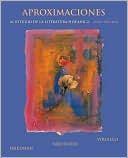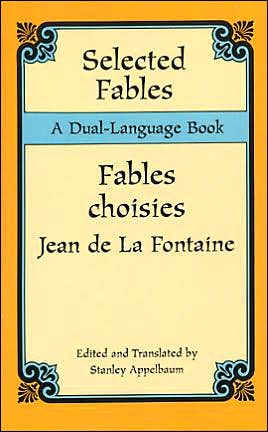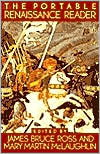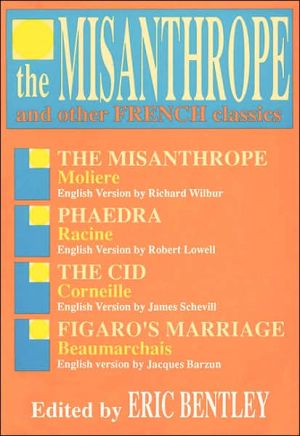The Complete Fables of Jean de La Fontaine
Inspired new translations of the work of one of the world's greatest fabulists\ Told in an elegant style, Jean de la Fontaine's (1621-95) charming animal fables depict sly foxes and scheming cats, vain birds and greedy wolves, all of which subtly express his penetrating insights into French society and the beasts found in all of us. Norman R. Shapiro has been translating La Fontaine's fables for over twenty years, capturing the original work's lively mix of plain and archaic language. This...
Search in google:
Inspired new translations of the work of one of the world's greatest fabulists Told in an elegant style, Jean de la Fontaine's (1621-95) charming animal fables depict sly foxes and scheming cats, vain birds and greedy wolves, all of which subtly express his penetrating insights into French society and the beasts found in all of us. Norman R. Shapiro has been translating La Fontaine's fables for over twenty years, capturing the original work's lively mix of plain and archaic language. This newly complete translation is destined to set the English standard for this work. Awarded the Lewis Galantière Prize by the American Translators Association, 2008.Katherine K. Koenig - Library JournalAbly translated from the French by Shapiro (Romance languages & literature, Wesleyan Univ.), the voices of the animals, birds, insects (and even the occasional human) who populate La Fontaine's fables come alive in rhyme and rhythm that develop the traditional tales. Some rhyme seems technically forced, with line breaks in awkward places: "cheese; it" to rhyme with "seize it"; the awkward "circumspecter" to rhyme with "protector"; "forasmuch, it" coupled with "touch it." The rhythm, on sight reading, is also sometimes uneven: "They tell about two thieves who fought/Over a stolen ass: one thought/It should be kept." Yet somehow these imperfections merely enhance the humor and, when read aloud, both rhyme and rhythm flow well, perhaps even better than more perfect poetic versions. And since these fables are now, as they always have been, at their best in oral performance, that is an asset. For libraries lacking a collection of La Fontaine's fables, needing a new copy, or looking for a comprehensive single volume, this one will do nicely.
The Complete Fables of Jean de La Fontaine\ \ By Jean de La Fontaine \ University of Illinois Press\ Copyright © 2007 Norman R. Shapiro\ All right reserved.\ ISBN: 978-0-252-07381-6 \ \ \ \ Preface\ I am a self-confessed La Fontaine addict. Unlike other addictions, this one is quite harmless. It even has an upside. My translations can help introduce those with limited or no French to the genius of the genial fabulist; and even, perhaps-though doubtful-improve the behavior of a reader or two. ("Doubtful," because, though I myself have translated many hundreds of fables over the years, despite all their edifying content I am still as flawed a human being as I was when I began. And anyway, it is unlikely that La Fontaine's intent for his little moral tales was truly as didactic as his first six books would have us believe. Their artistry far transcends their morality.) \ But it has a definite downside too, by definition. La Fontaine's oeuvre, after all, like any author's, is finite. When, in 1988, I brought out my collection Fifty Fables of La Fontaine, even though I had no conscious intention at the time of doing another, the possibility of continuing to feed my happy addiction was always there. It surfaced with Fifty More Fables in 1998; and again, with Once Again, La Fontaine, a couple of years later. After each backsliding, though, I dutifully resolved that I would reform.\ So much for resolutions. I went on, in my all-too-human frailty, to complete the remaining fourscore a couple of years ago, blithely ignoring the fact that the supply would thereby dry up. (And, to the best of my knowledge, there are no treatment centers to deal with La Fontaine addiction.) There are, to be sure, other competent, attractive, even thoroughly engaging French fable writers-scores and scores of them, in fact, over the centuries. And I have dealt with many. But there is only one La Fontaine. I can, of course, hope that researchers may eventually discover a trove of as yet unknown La Fontaine fables. But even that unlikely serendipity would be only a temporary solution at best. And so my "collaboration" with him, while an ongoing joy, is tempered by the knowledge that it now exists in retrospect and not in anticipation. I am both enriched by the past and saddened by its finality.\ That confessed, what I present here is the integral fruit of that benignly compelling collaboration with this dean of French fabulists: translations-versions? re-creations?-of his complete Fables, in the sweep of their twelve books extending over his entire literary life, from 1668 to 1694; developing from the child-friendly and uncomplicated minidramas of the earliest, through narratives of greater philosophical and literary complexity-hardly children's fare; and even unto the lengthy but never ponderous works in the late books. Some of these latter are not, in fact, "fables" at all, but rather contes-tales in the style of his often licentious Contes et nouvelles en vers. But who am I to argue? Included with the fables since their first publication (by either La Fontaine or his publisher), they are traditionally part of the corpus; and for the sake of truth in advertising I include them in the announced completeness of the present collection. I hope readers will be as undaunted by "Philemon and Baucis," "The Daughters of Mineas," and the several others, as by "Maître Corbeau, sur un arbre perché ..." and his quite different ilk, which are much more readily committed to the memory of generations of French school children. They will be rewarded with a view of La Fontaine's narrative talent that literary histories often fail to mention but that shows many of the same qualities that make him unique.\ A few words are in order concerning my own philosophy as a translator, especially of verse, and, more especially, of La Fontaine's. Without embarking on a screed-like discussion of the "rhyme-and-meter versus free-verse" controversy between "formalists" and "literalists," which will never lose steam among Translation Studies adepts, I would say only that for me-and individual taste is crucial here-to render formal (i.e., rhymed and metered) verse into anything but similar English is tantamount to artistic sacrilege. If the "message" is all the reader wants, a prose (or prosy) rendition is fine. The Lambs' Tales from Shakespeare, I might point out hyperbolically, does serve a valuable purpose, after all. But the message is only part of a poet's artifact. If he or she clothes it in rhymed and metered verse, to do less is to betray at least part of its essence and to become the proverbial translator-cum-traitor, all other things being equal. Granted, no translation will ever "reproduce" the original exactly, but why should it? That is not the translator's purpose. What he or she aims to do is to create a self-contained, self-standing work, one that has an almost mystical connection with the original, but a work that, ostensibly independent, transmits, to whatever degree it can, its music as well as its message. Or, in the words of Seamus Heaney, "the tone" as well as "the tune." A translator tries to do this without sacrificing either to the other. The product must be seamless, and, not calling attention to itself except by choice, must sound as unforced and, indeed, inevitable, as the text that spawned it.\ In translating La Fontaine, the preceding observations are especially pertinent. His free-and-easy vers libres (i.e., freeish, not free, verse, in seventeenth-century usage), for all their liberty-their run-on lines, their natural speech rhythms, their inner rhymes and melodic repetitions-are no less set against an underlying metrical grid that constrains and intensifies that freedom. To render them into a rhymeless, meterless English would be rather like turning Shakespeare's blank verse iambics into French rhymed octosyllabic couplets, or Dante's terza rima into sprightly limericks. It's safe to say that something would be lost... La Fontaine's vehicle is as much a part of his organic whole as are his subjects and his style. He is always there, at the reader's elbow, watching, with a complicitous wink and nod, the reaction to a bit of stylistic liberty, an unexpected archaism, an egregious rhyme, a sudden change of meter or line length for dramatic impact. Even, at times, the introduction of a one- or two-syllable word to function as an entire line. To ignore such bits of (deceptively?) casual-sounding inspiration would, for me at least, be unthinkable.\ Now, this does not mean that I think the translator should try to follow his form with a slavish fidelity. For La Fontaine, as for generations of French versifiers before, during, and after, the standard poetic line is the twelve-syllable alexandrine. But he is also generous in adding to the mix a variety of decasyllables, octosyllables, and even shorter lines, not to mention a spate of so-called impair (uneven-numbered) lines. All for conscious (or perhaps even unconscious, instinctive) effect. And all in an effort to maintain the naturalness of prose in the formal but unobtrusive trappings of verse. In English poetry, as Pope tells us, the twelve-syllable line is overlong and heavy. Occasional use can be effective, as it is in Pope's own picturesquely sarcastic example: "that like a wounded snake drags its slow length along ..." But it makes more aesthetic sense to use its canonical English equivalent, the iambic pentameter, and to mold it flexibly into a convincing whole, with recourse to lines of other lengths as the rhetorical and dramatic situation demands.\ In other words, the reader who troubles to compare my individual lines with La Fontaine's will not usually find a one-for-one correspondence. Such an aping of his line lengths, although perhaps a virtuoso accomplishment, would be an artistically useless one, since, except for a few set pieces in quatrains, he follows no recognizable formal patterns himself. His prosodic freedom-like the freedom of the natural universe in which his characters live their slices of life for us-is, in fact, one of his hallmarks and one of his greatest charms. Some translators (and readers) will disagree. So be it. Here I stand. Others, with as much of a claim to credibility, stand elsewhere.\ Let the reader decide ...\ * * *\ My thanks to my many staunch friends and colleagues for assistance both practical and aesthetic. Evelyn Singer Simha has, as ever, been foremost among them, and exemplary in every regard, with her usual-unusual!-generously proffered advice; and Caldwell Titcomb has always been ready with valuable observations, linguistic and historical.\ Most of these translations were written in the comfort of Adams House, Harvard University, where, thanks to the hospitality of its comasters, Doctors Judy and Sean Palfrey, and their assistant victoria Macy, I enjoy the position of writer-in-residence. Let it be said that my friends on its dining hall staff have also played a very sustaining and tasteful role.\ My own university, Wesleyan, has likewise been most supportive with a number of grants, especially one founded by my late colleague Professor Joseph McMahon in memory of his parents. Such help has been invaluable, as has the much appreciated interest of Tom Radko and Suzanna Tamminen of the Wesleyan University Press. I am no less indebted to Sylvia and Allan kliman for their encouragement; to Michael Weidman, French Wall, Todd Houle, and Glenn Carlson for their electronic know-how; to Rosalind Eastaway and Linda Cummings for frequent secretarial help; and to a bevy of research assistants-Sophie Hermann, Rachel Hoffman Bengtzen, and Daniela Cammack-for their efficiency and good cheer.\ I should like also to acknowledge that the idea of this complete edition was the inspiration of Dr. Willis Regier, who, with his staff at the University of Illinois Press-especially Cope Cumpston and Dawn McIlvain-has been most cooperative and supportive. To each and all, my gratitude, with a special word of appreciation to enthusiastic fablephile Liz Dulany for getting the ball rolling in the first place. And, of course, my thanks to colleague and frequent past collaborator David Schorr, whose whimsical graphic talents provide such fitting company for La Fontaine's verbal art, as well as to John Hollander for his appreciative and always appreciated insights.\ * * *\ Henri Regnier's eleven-volume critical edition Oeuvres de J. de la Fontaine (rev. ed. [Paris: Hachette, 1883-92]), replete with copious annotations, has served as source of many of my notes. I have chosen to prepare my versions from the French text of the Fables as presented by Ferdinand Gohin in the Association Guillaume Budé's two-volume edition, Oeuvres complètes de La Fontaine (Paris: Société des Belles Lettres, 1934), which purports to be a faithful representation of the last edition corrected by La Fontaine himself.\ Publication of this book has been aided by a grant from the Thomas and Catharine McMahon Fund of Wesleyan University, established through the generosity of the late Joseph McMahon.\ (Continues...)\ \ \ \ \ Excerpted from The Complete Fables of Jean de La Fontaine by Jean de La Fontaine Copyright © 2007 by Norman R. Shapiro. Excerpted by permission.\ All rights reserved. No part of this excerpt may be reproduced or reprinted without permission in writing from the publisher.\ Excerpts are provided by Dial-A-Book Inc. solely for the personal use of visitors to this web site. \ \
Contents Translator's Preface....................xviiIntroduction by John Hollander....................xxiiiThe Fables For Monseigneur le Dauphin....................1BOOK I The Cricket and the Ant....................5The Crow and the Fox....................5The Frog Who Would Grow as Big as the Ox....................6The Two Mules....................6The Wolf and the Hound....................7The Heifer, the Goat, and the Lamb in Consort with the Lion....................8The Beggar's Sack....................9The Swallow and the Little Birds....................10The City Rat and the Country Rat....................12The Wolf and the Lamb....................13The Man and His Image....................14The Dragon with Many Heads and the Dragon with Many Tails....................15The Thieves and the Ass....................16Simonides Saved by the Gods....................17Death and the Wretched Man & Death and the Woodsman....................19The Middle-aged Man and His Two Mistresses....................21The Fox and the Stork....................22The Child and the Schoolmaster....................23The Cock and the Pearl....................24The Hornets and the Honeybees....................24The Oak and the Reed....................25BOOK II Against Those with Too Difficult Tastes....................29The Rats in Council Assembled....................31The Wolf Pleading against the Fox before the Ape....................32The Two Bulls and a Frog....................33The Bat and the Two Weasels....................33The Bird Wounded by an Arrow....................34TheMastiff Bitch and Her Friend....................35The Eagle and the Dung Beetle....................36The Lion and the Gnat....................37The Ass with a Load of Sponges and the Ass with a Load of Salt....................39The Lion and the Rat & The Dove and the Ant....................40The Astrologer Who Happens to Fall into a Well....................41The Hare and the Frogs....................43The Cock and the Fox....................44The Crow Who Wanted to Imitate the Eagle....................45The Peacock Who Complained to Juno....................46The Cat Metamorphosed into a Woman....................47The Lion and the Ass out Hunting....................48The Will Explained by Aesop....................49BOOK III The Miller, His Son, and the Ass....................55The Limbs and the Stomach....................57The Wolf Turned Shepherd....................59The Frogs Who Ask for a king....................60The Fox and the Goat....................61The Eagle, the Wild Sow, and the Cat....................62The Drunkard and His Wife....................64Gout and the Spider....................65The Wolf and the Stork....................66The Lion Brought Down by Man....................67The Fox and the Grapes....................67The Swan and the Cook....................67The Wolf and the Ewes....................68The Lion Grown Old....................69Philomela and Procne....................70The Drowned Wife....................70The Weasel in the Larder....................72The Cat and an Old Rat....................72BOOK IV The Lion in Love....................77The Shepherd and the Sea....................79The Fly and the Ant....................80The Gardener and His Lord....................82The Ass and the Pup....................84The War between the Rats and the Weasels....................85The Ape and the Dolphin....................86The Man with the Wooden Idol....................88The Jay Dressed in the Peacock's Feathers....................89The Camel and the Floating Sticks....................89The Frog and the Rat....................90The Tribute Sent by the Animals to Alexander....................91The Horse Who Sought Revenge on the Stag....................94The Fox and the Bust....................95The Wolf, the She-goat, and the kid & The Wolf, the Mother, and the Child....................96A Reflection from Socrates....................98The Old Man and His Sons....................98The Oracle and the Infidel....................100The Miser Who Lost His Treasure....................101The Master's Eye....................102The Lark, Her Little Ones, and the Farmer Who Owns the Field....................103BOOK V The Woodsman and Mercury....................109The Earthen Pot and the Iron Pot....................111The Little Fish and the Fisherman....................112The Hare and His Ears....................113The Fox Who Lost His Tail....................114The Old Woman and the Two Servants....................115The Satyr and the Passerby....................116The Horse and the Wolf....................117The Ploughman and His Sons....................118The Mountain in Labor....................119Dame Fortune and the Child....................119The Doctors....................120The Hen with the Golden Eggs....................120The Ass with a Load of Holy Relics....................121The Deer and the vine....................121The Snake and the File....................122The Hare and the Partridge....................123The Eagle and the Owl....................124The Lion Going Off to War....................125The Bear and the Two Companions....................126The Ass Dressed in the Lion's Skin....................127BOOK VI The Shepherd and the Lion & The Lion and the Hunter....................131Phoebus and Boreas....................133Jupiter and the Farmer....................134The Cockerel, the Cat, and the Little Mouse....................135The Fox, the Ape, and the Animals....................136The Mule Who Boasted of His Family Tree....................137The Old Man and the Ass....................138The Stag Who Sees Himself in the Water....................139The Hare and the Tortoise....................139The Ass and His Masters....................141The Sun and the Frogs....................142The Peasant and the Snake....................142The Sick Lion and the Fox....................143The Bird-catcher, the Hawk, and the Lark....................144The Horse and the Ass....................145The Dog Who Drops His Prey for Its Reflection....................145The Wagoner Stuck in the Mud....................146The Charlatan....................147Discord....................148The Young Widow....................149Epilogue....................151BOOK VII For Madame de Montespan....................155The Animals Ill with the Plague....................156The Man Who Married a Shrew....................158The Rat Who Withdrew from the World....................160The Heron & The Damsel....................161The Wishes....................163King Lion's Court....................165The vultures and the Pigeons....................166The Coach and the Fly....................168The Milkmaid and the Milk Jug....................169The Curé and the Corpse....................170The Man Who Runs after Fortune and The Man Who Waits for Her in His Bed....................172The Two Cocks....................174The Ingratitude and Injustice of Men toward Fortune....................175The Fortune-tellers....................177The Cat, the Weasel, and the Little Rabbit....................179The Snake's Head and Tail....................180An Animal in the Moon....................181BOOK VIII Death and the Dying Man....................187The Cobbler and the Financier....................189The Lion, the Wolf, and the Fox....................190The Power of Fables....................192The Man and the Flea....................194Women and Secrets....................195The Dog Who Carries His Master's Dinner around His Neck....................196The Joker and the Fish....................197The Rat and the Oyster....................198The Bear and the Garden-lover....................200The Two Friends....................202The Hog, the Goat, and the Sheep....................203Tircis and Amaranth....................204The Lioness's Funeral....................206The Rat and the Elephant....................208The Horoscope....................209The Ass and the Dog....................212The Pasha and the Merchant....................213The value of knowledge....................215Jupiter and the Thunderbolts....................216The Falcon and the Capon....................218The Cat and the Rat....................219The Torrent and the Rivulet....................221Breeding....................222The Two Dogs and the Dead Ass....................223Democritus and the Abderitans....................225The Wolf and the Hunter....................226BOOK IX The Faithless Trustee....................231The Two Pigeons....................234The Ape and the Leopard....................236The Acorn and the Pumpkin....................237The Schoolboy, the Pedant, and the Owner of a Garden....................239The Sculptor and the Statue of Jupiter....................240The Mouse Metamorphosed into a Maiden....................241The Madman Who Sells Wisdom....................244The Oyster and the Adversaries....................245The Wolf and the Scrawny Dog....................246All in Moderation....................247The Taper....................248Jupiter and the Traveler....................249The Cat and the Fox....................250The Husband, the Wife, and the Thief....................251The Treasure and the Two Men....................253The Monkey and the Cat....................254The Kite and the Nightingale....................255The Shepherd and His Flock....................256Discourse [for Madame de la Sablière]....................257The Two Rats, the Fox, and the Egg....................262BOOK X The Man and the Snake....................267The Turtle and the Two Ducks....................269The Fishes and the Cormorant....................270The Money-burier and His Friend....................272The Wolf and the Shepherds....................273The Spider and the Swallow....................275The Partridge and the Cocks....................276The Dog Who Had His Ears Cut Short....................276The Shepherd and the king....................277The Fishes and the Shepherd Who Plays the Flute....................280The Two Parrots, the king, and His Son....................281The Lioness and the She-bear....................283The Two Adventurers and the Wondrous Writ....................284Discourse [for Monsieur le duc de la Rochefoucauld]....................286The Merchant, the Aristocrat, the Shepherd, and the Prince....................288BOOK XI The Lion....................293The Gods Wishing to Instruct a Son of Jupiter....................294The Farmer, the Hound, and the Fox....................296The Dream of the Man from the Mogol Land....................298The Lion, the Ape, and the Two Asses....................300The Wolf and the Fox....................302The Peasant from the Danube....................304The Old Man and the Three Young Men....................307The Mice and the Screech Owl....................308Epilogue....................309BOOK XII The Companions of Ulysses....................313The Cat and the Two Sparrows....................316The Treasure-hoarder and the Ape....................317The Two Goats....................319For Monseigneur le duc de Bourgogne....................320The Old Cat and the Young Mouse....................321The Sick Stag....................322The Bat, the Bush, and the Duck....................323The Quarrel of the Dogs and Cats and of the Cats and Mice....................324The Wolf and the Fox....................326The Crayfish and Her Daughter....................328The Eagle and the Magpie....................329The kite, the king, and the Fowler....................330The Fox, the Flies, and the Hedgehog....................334Love and Folly....................335The Crow, the Gazelle, the Tortoise, and the Rat....................336The Forest and the Woodsman....................340The Fox, the Wolf, and the Horse....................341The Fox and the Young Turkey Cocks....................343The Ape....................344The Scythian Philosopher....................344The Elephant and Jupiter's Ape....................345A Fool and a Wise Man....................347The English Fox....................347Daphnis and Alcimadura....................350Philemon and Baucis....................353The Matron of Ephesus....................359Belphegor....................365The Daughters of Mineas....................373The Arbiter, the Hospitaler, and the Hermit....................395APPENDIXES The Sun and the Frogs....................399The Rats' League....................400Notes....................403Notes on Illustrations....................441Bibliography....................445Index....................449
\ Library JournalAbly translated from the French by Shapiro (Romance languages & literature, Wesleyan Univ.), the voices of the animals, birds, insects (and even the occasional human) who populate La Fontaine's fables come alive in rhyme and rhythm that develop the traditional tales. Some rhyme seems technically forced, with line breaks in awkward places: "cheese; it" to rhyme with "seize it"; the awkward "circumspecter" to rhyme with "protector"; "forasmuch, it" coupled with "touch it." The rhythm, on sight reading, is also sometimes uneven: "They tell about two thieves who fought/Over a stolen ass: one thought/It should be kept." Yet somehow these imperfections merely enhance the humor and, when read aloud, both rhyme and rhythm flow well, perhaps even better than more perfect poetic versions. And since these fables are now, as they always have been, at their best in oral performance, that is an asset. For libraries lacking a collection of La Fontaine's fables, needing a new copy, or looking for a comprehensive single volume, this one will do nicely.\ —Katherine K. Koenig\ \ \








